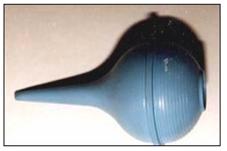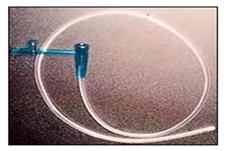신생아 흡인성 폐렴 Aspiration pneumonia in newborn infants
분만 전이나, 분만 중, 또는 분만 직후에 태아나 신생아가 양수, 엄마가 흘린 피, 태변 등을 기도 속으로 흡인해서 생긴 폐렴을 신생아 흡인 폐렴이라고 한다.
| 신생아 흡인 폐렴의 원인 |
① 보통 이상으로 오랜 시간 걸려 분만해서 태어난 신생아
② 양막이 터지고 시간이 많이 경과한 후에 분만하여 태어난 신생아
③ 난산으로 태어난 신생아
④ 태아가 자궁 속에서 산소 공급을 충분히 받지 못해서 양수 및 태변을 폐 속으로 흡인한 후 태어날 때
⑤ 출생 이후 신생아 자신이 토한 위장 내용물이 신생아의 기도 속으로 흡인됐을 때도 흡인성 폐렴에 걸릴 수 있다. 구토 물을 기도 속으로 흡인될 때는 흡인 물과 박테리아가 함께 폐 속으로 흡인돼서 폐 속으로 들어가게 된다. 늑막염과 농흉, 기흉 참조.
⑥ 그 외 다른 원인으로 갓 태어난 신생아에게 흡인성 폐렴이 생길 수 있다.
| 신생아 흡인 폐렴의 증상 징후 |

사진 161. 흡입구(흡인구/Suction bulb).
신생아의 비강, 입안, 인두 강 등에 있는 태변, 피, 구토물 등을 흡인해서 기도가 열리게 하고 호흡을 잘 하도록 돕고 흡인 폐렴 등을 예방하는데 흡입구를 주로 쓴다.
Copyright ⓒ 2011 John Sangwon Lee, MD., FAAP

사진 162. 흡입관.
신생아의 비강, 입안, 인두 등에 있는 태변, 피, 구토물 등을 흡인해 기도가 열리게 하고 호흡을 잘 할 수 있게 도와주고 흡인 폐렴을 예방하는데 주로 쓴다.
Copyright ⓒ 2011 John Sangwon Lee, MD., FAAP
- 신생아의 하기도 속으로 흡인된 구토 물, 피, 양수 등의 양과 흡인성 폐렴의 정도에 따라 증상 징후가 조금씩 다를 수 있다.
- 심한 흡인 폐렴의 전형적인 증상 징후는 다음과 같다.
- 숨이 가쁘고, 피부가 창백하거나 파랗다. 숨 쉴 때 신음소리를 내기도 한다. 박테리아 감염이 없고 흡인 폐렴만 있을 때는 열이 나지 않는 것이 보통이다.
- 흡인 폐렴에 박테리아 감염이 2차적으로 생겨 박테리아 폐렴이 동시 있을 때는 열이 날 수 있다. 젖이나 인공영양을 잘 빨아먹지 않는다.
- 이런 증상 징후가 며칠 또는 1~2주간 계속될 수 있다.
신생아 흡인성 폐렴의 진단 치료
- 병력, 증상 징후, 진찰소견 등을 종합해서 이 병이 의심되면 가슴 X선 사진 검사로 진단한다.
- 초기에는 박테리아 폐렴이나 바이러스 폐렴, 또는 흡인 폐렴을 서로 확실히 감별 진단하기 어려운 때가 많다.
- 따라서 박테리아 폐렴이나 바이러스 폐렴이 아니라고 진단을 한 다음에 역으로 흡인 폐렴이라고 진단하는 때가 많다.
- 사실상 신생아의 폐 속으로 태변이나 피 등이 흡인될 때 박테리아도 같이 흡인될 때가 많다.
- 따라서 박테리아 감염성 폐렴이 하나도 없이 순 흡인 폐렴만 생기는 경우는 아주 드물다.
- 신생아의 체온을 정상으로 유지하기 위해서 보육기 속에서 치료할 때가 많다.
- 필요에 따라 산소호흡 치료를 하고, 포도당 전해질용액 정맥주사로 탈수치료도 한다.
- 일반적으로 박테리아 폐렴이 아니라는 것을 확실히 알 때까지는 광범위 항생제 혈관 주사 치료하는 것이 보통이다.
Aspiration pneumonia in newborn infants 신생아 흡인성 폐렴
Pneumonia caused by aspiration of amniotic fluid, blood, meconium, etc. from the fetus or newborn into the airways before, during, or immediately after delivery is called neonatal aspiration pneumonia.
Causes of neonatal aspiration pneumonia
① Newborns born after delivery takes longer than usual
② Newborns born after delivery after a long period of time has elapsed after the amniotic membrane has burst
③ Newborns born with difficulty
④ When the fetus is born after aspirating amniotic fluid and meconium into the lungs due to insufficient oxygen supply in the womb
⑤ Aspiration pneumonia can occur even when the contents of the stomach that the newborn vomits after birth are aspirated into the newborn’s airways.
When vomiting water is aspirated into the airways, the aspirated water and bacteria are sucked into the lungs together and enter the lungs. See also pleurisy, empyema, and pneumothorax.
⑥ Aspiration pneumonia can occur in newborn babies due to other causes.
Symptoms signs of neonatal aspiration pneumonia

Picture 161. Suction port (Suction bulb). Inhalation is mainly used to open the airways by aspirating meconium, blood, vomit, etc. in the nasal cavity, mouth, and pharyngeal cavity of newborns, helping to breathe well and preventing aspiration pneumonia. Copyright ⓒ 2011 John Sangwon Lee, MD., FAAP

Picture 162. Suction pipe. It is mainly used to open the airways by aspirating meconium, blood, vomit, etc. in the nasal cavity, mouth, and pharynx of newborns, helping to breathe well, and preventing aspiration pneumonia. Copyright ⓒ 2011 John Sangwon Lee, MD., FAAP
• Symptoms may vary slightly depending on the amount of vomit, blood, amniotic fluid, etc. aspirated into the lower respiratory tract of a newborn and the severity of aspiration pneumonia.
• Typical symptomatic signs of severe aspiration pneumonia are:
• I have shortness of breath and my skin is pale or blue. It may make a moan when breathing. When there is no bacterial infection and only aspiration pneumonia is present, the fever is usually absent.
• Aspiration pneumonia is a secondary bacterial infection that can cause fever when bacterial pneumonia is present at the same time.
Does not suck up milk or artificial nutrition well.
• Signs of these symptoms may last for days or for a week or two.
Diagnosis, treatment of neonatal aspiration pneumonia
• Comprehensive medical history, symptoms, and examination findings. If this disease is suspected, it is diagnosed with a chest X-ray examination.
• In the beginning, it is often difficult to reliably differentiate between bacterial pneumonia, viral pneumonia, or aspiration pneumonia.
• Therefore, it is often diagnosed as not bacterial pneumonia or viral pneumonia and then diagnosed as reverse aspiration pneumonia.
• In fact, when the meconium or blood is aspirated into the newborn’s lungs, bacteria are often aspirated as well.
• Therefore, it is very rare to develop pure aspiration pneumonia without any bacterial infectious pneumonia.
• In order to keep the newborn’s body temperature normal, it is often treated in an incubator.
• If necessary, oxygen respiration treatment is performed, and dehydration treatment is also performed by intravenous injection of a glucose electrolyte solution.
• In general, broad-spectrum antibiotic vascular injections are usually given until you know it is not bacterial pneumonia.
출처 및 참조 문헌 Sources and references
- NelsonTextbook of Pediatrics 22ND Ed
- The Harriet Lane Handbook 22ND Ed
- Growth and development of the children
- Red Book 32nd Ed 2021-2024
- Neonatal Resuscitation, American Academy Pediatrics
-
www.drleepediatrics.com제7권 소아청소년 감염병
-
www.drleepediatrics.com제8권 소아청소년 호흡기 질환
- The Johns Hopkins Hospital, The Harriet Lane Handbook, 22nd editio
- www.drleepediatrics.com제6권. 신생아의 성장 발육 양육 질환
- The Johns Hopkins Hospital, The Harriet Lane Handbook, 20th edition
- Red book 29th-31st edition 2021
- Nelson Text Book of Pediatrics 19th-21st Edition
-
Childhood Emergencies in the Office, Hospital and Community, American Academy of Pediatrics
-
Emergency Medical Service for Children, By Ross Lab. May 1989. p.10
-
Emergency care, Harvey grant, and Robert Murray
-
Emergency Care Transportation of Sick and Injured American Academy of Orthopaedic Surgeons
-
Emergency Pediatrics A Guide to Ambulatory Care, Roger M. Barkin, Peter Rosen
-
Immediate care of the acutely ill and injured, Hugh E. Stephenson, Jr
-
The Critically Ill Child, Diagnosis and Management, Edited by Clement A. Smith
-
Emergency Medical Services for Children: The Role of the Primary Care Provider, America Academy of Pediatrics
-
Quick Reference To Pediatric Emergencies, Delmer J. Pascoe, M.D., Moses Grossman, M.D. with 26 contributors
-
Manual of Emergency Care
-
응급환자관리 정담미디어
-
소아가정간호백과–부모도 반의사가 되어야 한다, 이상원
-
Neonatal Resuscitation American heart Association
-
Neonatology Jeffrey J.Pomerance, C. Joan Richardson
-
Pediatric Resuscitation Pediatric Clinics of North America, Stephen M. Schexnayder, M.D.
-
Pediatric Critical Care, Pediatric Clinics of North America, James P. Orlowski, M.D.
-
Preparation for Birth. Beverly Savage and Dianna Smith
- Infectious disease of children, Saul Krugman, Samuel L Katz, Ann A. Gershon, Catherine Wilfert
-
The Harriet Lane Handbook 19th Edition
-
소아과학 대한교과서
-
제1권 소아청소년 응급의료 참조문헌과 출처
-
Other
Copyright ⓒ 2015 John Sangwon Lee, MD., FAAP
“부모도 반의사가 되어야 한다”-내용은 여러분들의 의사로부터 얻은 정보와 진료를 대신할 수 없습니다.
“The information contained in this publication should not be used as a substitute for the medical care and advice of your doctor. There may be variations in treatment that your doctor may recommend based on individual facts and circumstances. “Parental education is the best medicine.”